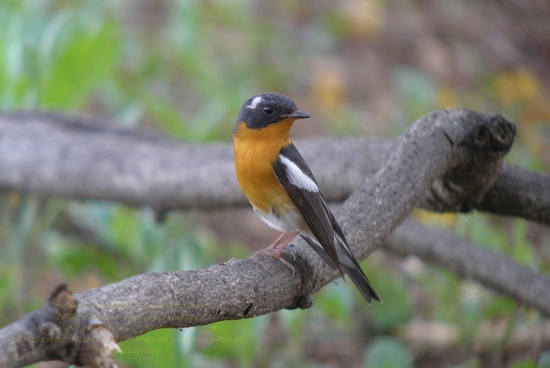m |
(Attempt to disguise some copied text. Taxonomy. References. Incomplete gone) |
||
| Line 1: | Line 1: | ||
| − | + | [[Image:Mugmaki FC 3.jpg|thumb|550px|right|Photo by {{user|mohbhorn|mohbhorn}}<br /> Vachirabenjatas Park, Bangkok, [[Thailand]]]] | |
| − | [[Image:Mugmaki FC 3.jpg|thumb|550px|right|Photo by {{user|mohbhorn|mohbhorn}} | ||
| − | |||
'''Alternative name: Robin Flycatcher''' | '''Alternative name: Robin Flycatcher''' | ||
;[[:Category:Ficedula|Ficedula]] mugimaki | ;[[:Category:Ficedula|Ficedula]] mugimaki | ||
| − | |||
==Identification== | ==Identification== | ||
| − | 13 to 13.5 cm | + | 13 to 13.5 cm<br /> |
| − | + | *Black upperparts | |
| + | *Short white supercilium | ||
| + | *White wing-patch | ||
| + | *White edges to the tertials | ||
| + | *White at the base of the outer tail-feathers | ||
| + | *Orange red breast and throat | ||
| + | *White belly and undertail-coverts<br /> | ||
| + | [[Image:Mugimaki_Flycatcher.jpg|thumb|350px|right|Photo by {{user|jweeyh|jweeyh}}<br />[[Bukit Timah Nature Reserve]], [[Singapore]]]] | ||
| + | '''Female''' | ||
| + | *Grey-brown above | ||
| + | *Pale orange-brown breast and throat | ||
| + | *No white in the tail | ||
| + | *One or two pale wingbars | ||
| + | *Faint or absent supercilium<br /> | ||
| + | '''Young males'''<br /> | ||
| + | *Similar to the female but have a brighter orange breast, white in the tail and a more obvious supercilium. | ||
==Distribution== | ==Distribution== | ||
| − | + | They range from [[Eurasia]] north of the [[Himalayas]], north-eastern [[China]], [[Japan]], and they fly to e.g., [[Singapore]] in migration. | |
| + | Accidental vagrant to [[Alaska]] with 1 record. | ||
==Taxonomy== | ==Taxonomy== | ||
| + | Monotypic<sup>[[#References|[1]]]</sup> | ||
==Habitat== | ==Habitat== | ||
High altitude forest and woodland. | High altitude forest and woodland. | ||
==Behaviour== | ==Behaviour== | ||
Its diet includes insects which are caught in flight. | Its diet includes insects which are caught in flight. | ||
| + | ==References== | ||
| + | #{{Ref-Clements6thDec08}}#Wikipedia | ||
| + | {{ref}} | ||
==External Links== | ==External Links== | ||
{{GSearch|Ficedula+mugimaki}} | {{GSearch|Ficedula+mugimaki}} | ||
[[Category:Birds]] [[Category:Ficedula]] | [[Category:Birds]] [[Category:Ficedula]] | ||
Revision as of 20:35, 26 November 2009
Alternative name: Robin Flycatcher
- Ficedula mugimaki
Identification
13 to 13.5 cm
- Black upperparts
- Short white supercilium
- White wing-patch
- White edges to the tertials
- White at the base of the outer tail-feathers
- Orange red breast and throat
- White belly and undertail-coverts
Female
- Grey-brown above
- Pale orange-brown breast and throat
- No white in the tail
- One or two pale wingbars
- Faint or absent supercilium
Young males
- Similar to the female but have a brighter orange breast, white in the tail and a more obvious supercilium.
Distribution
They range from Eurasia north of the Himalayas, north-eastern China, Japan, and they fly to e.g., Singapore in migration.
Accidental vagrant to Alaska with 1 record.
Taxonomy
Monotypic[1]
Habitat
High altitude forest and woodland.
Behaviour
Its diet includes insects which are caught in flight.
References
- Clements, JF. 2008. The Clements Checklist of Birds of the World. 6th ed., with updates to December 2008. Ithaca: Cornell Univ. Press. ISBN 978-0801445019.
- Wikipedia
Recommended Citation
- BirdForum Opus contributors. (2024) Mugimaki Flycatcher. In: BirdForum, the forum for wild birds and birding. Retrieved 8 June 2024 from https://www.birdforum.net/opus/Mugimaki_Flycatcher





